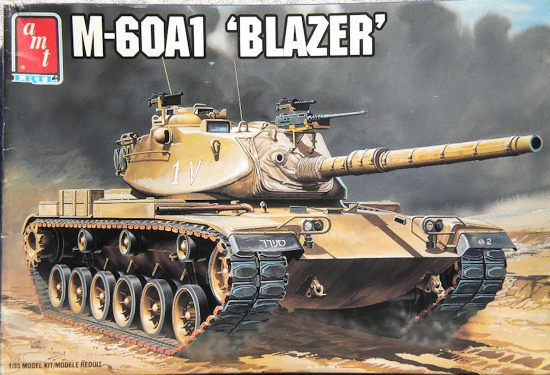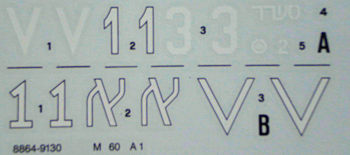
AMT/ERTL 1/35 M60A1 'Blazer'
| KIT #: | 8864 |
| PRICE: | $10.00 from vendor |
| DECALS: | Two options |
| REVIEWER: | Rick Reinbott |
| NOTES: | 346 parts on 5 sprues |

| HISTORY |
The M60 series tank is a direct descendant of the M26 Pershing. This family of tanks matured through continued development, resulting in the M46, M47, M48, M60, M60A1, M60A2 and M60A3. Development began in the 1956-57 time frame; initial steps consisted of fitting an M48 with an AVDS diesel engine and subsequently mounting a 105-mm VickersL7A1 gun in lieu of the 90-mm gun. Following further development, series production began and the vehicle entered service in 1960 as the M60. The M60A1 entered production in 1962 and incorporated a new, enlarged turret on the M60 chassis. In 1971 the United States began a series of major improvements and updates to the M60A1 including improved gunnery and targeting equipment, an upgraded engine and transmission, as well as other modifications.
The M60A1 “Blazer” incorporated technological improvements developed by the Israeli Army in response to the lessons learned in the Yom Kippur War of 1973. The Blazer refers to add-on reactive armor developed in Israel by RAFAEL. These reactive armor panels consisted of metal boxes with plastic explosives inside the outer face, which were bolted on the turret and hull. The reactive armor was designed to defeat HEAT warheads such as those used in TOW, Sagger, Copperhead and other anti-tank missles or rockets, by exploding the missle warhead before it hit the tank’s normal steel armor. Other modifications made by the Israelis included a low-profile commander’s cupola and commander’s mortar; a thermal sleeve on the main gun; improved smoke dischargers; replacement of the modern machine guns with more reliable, although older, Brownings; and modified external storage boxes. In addition to the Yom Kippur War, the M60 has seen action in the U.S. invasion of Grenada in 1983 and during Operation Desert Storm in 1991. The M60 is still in use by many nations today.
| THE KIT |
 Upon
opening the box, you’re presented with two bags, with one bag just containing
the sprue for the main hull and turret parts. No figures are included with the
kit. All parts are molded in medium tan and show very nice detail. There is very
little flash, although there are mold seams around most parts, which will need
to be scraped/ sanded for a smooth finish. Ejector pin marks are kept to the
inside surfaces of the wheels and tracks, so they will be pretty much out of
view after assembly. The box top indicates a copyright year of 1991.
Upon
opening the box, you’re presented with two bags, with one bag just containing
the sprue for the main hull and turret parts. No figures are included with the
kit. All parts are molded in medium tan and show very nice detail. There is very
little flash, although there are mold seams around most parts, which will need
to be scraped/ sanded for a smooth finish. Ejector pin marks are kept to the
inside surfaces of the wheels and tracks, so they will be pretty much out of
view after assembly. The box top indicates a copyright year of 1991.
The kit contains parts for building either a regular M60A1 or an Israeli M60A1 Blazer. The rough cast texture on the turret, commander cupolas, and hull is restrained and well represented. There is also a vehicle number molded on the top front portion of the upper hull part. The reactive armor for the Blazer variant is very well done. The .50 caliber cupola machine gun for the regular M60A1, as well as the .50-caliber and two .30-caliber Browning machine guns for the Blazer are molded solid, so they’ll need to be hollowed out if one wishes to use the kit parts. The 105mm main gun for the regular M60A1 and Blazer variant with the thermal sleeve are in two halves, but both are well detailed. The gun manlet features molded-on dust cover detail, which is nicely textured. There is a mold seam on the lower hull part that will need to be removed and there is what appears to be ejector pins on the individual wheel plates; check your references before removing these. The kit contains parts for the earlier side-loading air cleaners and the xenon search light. Wire for the tow cables is not included, yet the cable ends are and there are instructions for the wire lengths that would need to be cut. Screen is included for the wire mesh on the turret basket, and there is a stencil included for cutting out the right size to fit in the basket. Link and length type tracks are included. The tracks contain ejector pin marks on the interior surfaces and are the later T142 style with nicely rendered octagonal rubber blocks. There are also spare track links included to be attached to the turret. No clear parts are included.
The instructions are of the fold-out type and are well illustrated with
exploded views showing an A through Y construction sequence with substeps
included for the parts unique to each variant. A real bonus is that parts are
identifed as to what exactly they are, something that is not often seen to such
detail. There is a short history of the tank included. The painting guide shows
FS numbers for the colors. There are five color pictures of a completed Blazer
model on the box, which will be useful for reference. The decals are glossy with
mar kings for
two Israeli vehicles. One shows a three-tone camoflauge pattern for what apears
to be a U.S. vehicle. The painting guide includes:
kings for
two Israeli vehicles. One shows a three-tone camoflauge pattern for what apears
to be a U.S. vehicle. The painting guide includes:
An M60A1 Blazer variant with Israeli markings in overall FS-30277, which states “Brown” even though this color is a Sand tone; and a regular M60A1 in a three-tone camoflauge pattern of Sand (FS-33531), Dark Tan (FS-30219) and Field Drab (FS-30188). As I mentioned previously, this appears to be a U.S. camoflauge pattern, although the profile shows it with Israeli markings since there are no decals included for a U.S. vehicle.
| CONCLUSIONS |
I’ve read that this is one of the best 1/35 M60 kits that has been produced, and I would have to concur with that opinion! Recommended!
| REFERENCES |
Modern Armor: A Comprehensive Guide by Pierangelo Caiti, Squadron/Signal Publications (1978).
Kit instructions
Rick Reinbott
November 2016 Copyright ModelingMadness.com. If you would like your product reviewed fairly and fairly quickly, please contact the editor or see other details in the
Note to
Contributors.